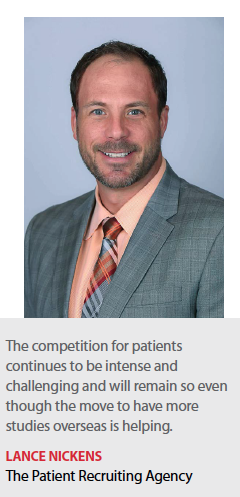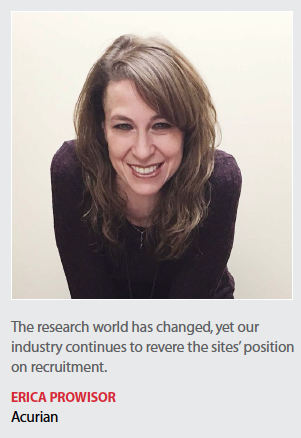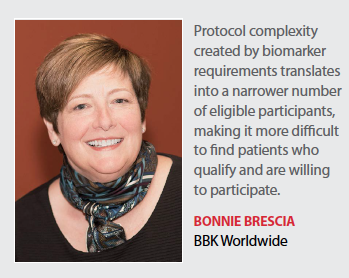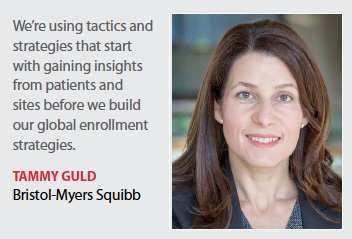Social media, mobile, and other technologies are making patient and physician outreach easier and more cost-effective and analytical tools are enhancing performance measurement, but patient recruitment for clinical trials continues to be a challenge.
This is especially true for trials involving rare diseases and oncology. For a rare disease, there is a smaller number of patients, and for some of these unique diseases, a patient organization may not even exist. Oncology medicines are becoming more targeted with a focus on determining which patients and tumors will respond to what medicines. These and other factors impact sponsors’ ability to recruit the appropriate patients for clinical studies.
Even though strides are being made to increase awareness around research opportunities, clinical studies are still not well understood, says Paulo Moreira, VP, global clinical operations, external innovation, EMD Serono and TransCelerate Program Lead.
“When we start digging and probing a little bit deeper as to why trials are not well-recruited, we find there is a lack of awareness, education, and access in terms of where healthcare professionals and patients can find information about clinical trials," he says.
Analysis last year conducted by the Tufts Center for the Study of Drug Development found that although physicians and nurses are familiar with, and comfortable discussing, clinical trials, they refer a mere fraction of their patients for these studies, reflecting, in part, a failure by sponsors, contract research organizations, and investigative site personnel to engage healthcare providers as partners in the clinical research process.
The study, based on a survey of 2,000 physicians and nurses primarily in the United States and Europe, found  that nearly all physicians (91%), and the majority of nurses (72%) feel somewhat or very comfortable discussing the opportunity to participate in a clinical trial with patients, but physicians refer fewer than 0.2% of their patients into clinical trials, and nurses refer even fewer.
that nearly all physicians (91%), and the majority of nurses (72%) feel somewhat or very comfortable discussing the opportunity to participate in a clinical trial with patients, but physicians refer fewer than 0.2% of their patients into clinical trials, and nurses refer even fewer.
Industry leaders say the way forward is to focus on the patients themselves. While patient-centricity has become an industry buzzword, truly centering the recruitment process around patients can lead to more effective recruitment and patient retention.
A survey of 2,346 pharma executives in 84 countries conducted by EyeforPharma in March 2015 indicated that they strongly believe in the importance of patient-centricity. They also believe patient-centricity is good for business — 93% said a patient-focused strategy improves business outcomes. About 92% said a long-term focus is required to implement patient-centric missions.
One company that is taking a patient-centric approach to clinical trial recruitment is Bristol-Myers Squibb. The company is interacting directly with patients and caregiver groups and leveraging social listening.
“Our strategies start with gaining insights from patients and sites before we build our global enrollment strategies," says Tammy Guld, who leads clinical trial planning at Bristol-Myers Squibb. “We hear directly from patients about their insights on our protocol, including the inclusion and exclusion criteria. We want to learn how a protocol could potentially burden them. This information is critical for us when we work to develop a final protocol, as well as how we think through an integrated, strategic enrollment strategy."
Bristol-Myers Squibb is also employing advanced analytics, which allows the company to leverage multiple external data facts and data sources to help target recruitment strategies or geographic areas.
Another company, Ipsen Biopharmaceuticals, has changed how it manages and recruits patients for clinical trials by focusing on patients.
Christine Seymour, director, clinical development programs at Ipsen Biopharmaceuticals, says the company works with patients from the start of the clinical trial set up.
“We meet with patients to understand their concerns, and we have at times adapted a protocol so it was easier for patients to participate in the trial," she says.
The company now has a chief patient affairs officer and teams specifically focused on patient recruitment.
“Previously, clinical operations was working only with the sites to find patients," she says. “Now with the support of dedicated teams that work on patients’ needs, we put in place advertisements, documentation, and videos for patients to help them understand the trial process."
Regulatory agencies also are recognizing the importance of engaging patients in the clinical trial process. In fact, for the first time, an FDA advisory committee was convened to focus on patient-related issues. In October 2017, the FDA held the inaugural meeting of the new Patient Engagement Advisory Committee. The meeting addressed challenges of clinical trial design, conduct, and reporting identified by patients for medical devices.
Ms. Guld says patient recruitment requires a connected customer experience.
“Patients will be able to see their ease of access and support of retention during their trial because the mobile and digital health transformation will continue to allow for the patient burden to reduce," she says. “They’ll understand that they could have in-home visits. There will be telemedicine. We will be able to collect data via a wearable or computer app or an e-source-type environment, so their burden will reduce tremendously. Reducing the stigma about how difficult or complex or scary a clinical trial might be for someone is key. As technology evolves and as we become more focused on the need of the patient, we’ll see more awareness and more access and willingness for patients to understand that this could be a care option for them."
Why Patient Recruitment Remains Difficult
There are several factors why patient recruitment remains challenging. One reason is that protocols are increasingly complex. Sponsors want more precision and very specific inclusion/exclusion criteria.
Recent data from the Center for Information & Study on Clinical Research Participation (CISCRP) suggests that the number of procedures required in a typical Phase III study has risen by more than 50%.
 “The complexity translates into a narrower number of eligible participants, making it more difficult to find patients who qualify," says Bonnie A. Brescia, founding principal, BBK Worldwide. “It’s not just that the protocols have too many different data points, it is also the complexity of the activities that take place during a visit or the distance that people need to travel to a site. As we make progress in certain areas, we put new types of pressure on recruitment. Some progress has been made to design protocols to take patient burden into consideration, but these improvements have been offset by more refined eligibility criteria making it more difficult to find patients who qualify and are willing to participate."
“The complexity translates into a narrower number of eligible participants, making it more difficult to find patients who qualify," says Bonnie A. Brescia, founding principal, BBK Worldwide. “It’s not just that the protocols have too many different data points, it is also the complexity of the activities that take place during a visit or the distance that people need to travel to a site. As we make progress in certain areas, we put new types of pressure on recruitment. Some progress has been made to design protocols to take patient burden into consideration, but these improvements have been offset by more refined eligibility criteria making it more difficult to find patients who qualify and are willing to participate."
As science has advanced over the years, there is now a focus on precision and targeted medicines.
“Precision medicine has led to an enormous amount of complexity within the clinical trial landscape," Ms. Guld says. “It is leading to more prescriptive eligibility criteria, more endpoints, and trial designs that have become adaptive in nature. While these changes are extremely important, sponsors need to think differently about finding the right patient at the right moment in time. This has led to a patient-centric, targeted approach in the last few years."
The impact of protocol complexity on patient recruitment has been enormous, says Lance Nickens, president, The Patient Recruiting Agency (TPRA).
“In addition, determining feasibility became that much more difficult," he says, adding that about five years ago, the pendulum started to move in the other direction toward more simplified protocols.
“While I am not qualified to speak to all of the reasons for this, I can say there has been an increasing awareness of the continuum from protocol design to recruitment efficiency that has played a role in simplifying protocols," Mr. Nickens says. “In turn, this has made recruitment a bit easier but it is still intensely competitive. However, we still have some very complex inclusion criteria, often from smaller pharmaceutical companies, so we think more work needs to be done in this area."
Mr. Nickens also points to the fact that clinical research is an adjunct to healthcare, an intensely personal matter.
“To expect movement between the two systems without material barriers is simply not realistic," he says. “Consider for a moment the average informed consent form, which embodies the differences between these two systems. From that perspective alone, a review of any informed consent form should yield an understanding that recruitment will be a challenge."
Additionally, he says competition for patients continues to be intense and challenging, and will remain so even though the movement of more studies overseas is helping.
 “This a real phenomenon at the site level as well as the outreach level, and it seems that many companies do not give adequate consideration to its impact," Mr. Nickens says.
“This a real phenomenon at the site level as well as the outreach level, and it seems that many companies do not give adequate consideration to its impact," Mr. Nickens says.
Ms. Seymour also notes that timelines in clinical development, which are often aggressive, is another factor that leads to trial recruitment challenges.
“We underestimate the time required and, most of the time, investigators overestimate their abilities to recruit," she says. “There is also a huge competition for patients. Companies are running trials requiring the same patient population so it’s even harder to find the patients, and this is why it is crucial to change the way we work and understand the patient concerns: to work with the patients for the patients."
Another challenge is getting patients from initial contact to randomization, says Erica Prowisor, executive director, global enrollment operations at Acurian.
“The combination of site and patient behaviors is not 100% predictable in the recruitment process and subject to many variables," she says. “CROs need to monitor for attrition at numerous points in the continuum: prescreening, first office visit, patient consent, and screen fail. And global studies will always present more of a challenge to recruiters, with widely varying regulatory and auditing requirements, medical standards of care, understanding and awareness of clinical research, literacy levels, etc. in each country."
What Works and What Doesn’t
Current patient recruitment methods are not working, says EB McLindon, VP, ICON.
“We as an industry are continuing to react to this challenge in the same way we always have — addressing issues as they arise," he says. “There is an over-reliance on information from site-level feasibility studies and heat maps to deliver predictability in patient recruitment. While this information increases the probability of accessing patients it doesn’t guarantee results."
When people describe patient recruitment as finding the proverbial needle in the haystack, the underlying issue is one of approach, Ms. Prowisor says.
“The research world has changed, yet our industry continues to revere the sites’ position on recruitment," she says. “It is increasingly difficult for principal investigators to source the majority of patients when the latter are unknown to the sites. Recruitment should no longer be the sole province of sites."
 Ms. Brescia from BBK Worldwide says what works in patient recruitment is a process, particularly one process that evaluates a protocol for what is needed to find patients who are willing to participate in clinical trials.
Ms. Brescia from BBK Worldwide says what works in patient recruitment is a process, particularly one process that evaluates a protocol for what is needed to find patients who are willing to participate in clinical trials.
“We have to build a plan to find who is that best match and only then can we determine what are the right methods and what’s the most appropriate approach," she says. “It’s my opinion that anybody who says ‘this doesn’t work’ or ‘this does work’ is missing the best way to get to success."
Ms. Prowisor says instead of relying on a single marketing method, selecting from the widest range of available marketing channels — and finding the right patients when they are most likely to engage — is the only way to generate high-potential study candidates with speed as well as accuracy.
“Every study and every protocol is unique, so the method must be tailored to the particular variables of the recruitment campaign: audience, geographic location, timing, etc.," she says. “There is no such thing as a one-size-fits-all approach, and a method that might not be effective for one campaign might be the best for another; it’s all about having patient insights and executing well based on those insights across multiple channels."
Most recruitment campaigns randomly blanket the media with general ads in the hope that qualified patients will reach the sites.
With patient-first feasibility, Ms. Prowisor says using patient insights based on data, focus groups, etc., is critical for effective patient recruitment. For each clinical trial, she recommends developing a patient profile by compiling, reviewing, and analyzing clinical and lifestyle data, including demographics, financial info, purchasing patterns, etc., along with the characteristics and profiles of people who previously matched and entered similar studies.
“This analysis occurs before we actually develop and conduct outreach, enabling us to specifically tailor our marketing plan to reach patients who are more likely to qualify for the study," she says. “Patient outreach also is customized for each protocol and indication, based not only on previous recruitment experience for that therapeutic area and indication, but also on feedback from indication-specific online groups."
Targeted recruitment marketing has gained significant traction and increased sophistication in recent years.
While there is more competition in the space, companies seem to be focusing less on metrics and more on “shiny objects," such as the latest digital marketing and social media tactic, Ms. Prowisor says.
Technology adoption in clinical trials has been positive and has improved clinical operations such as electronic data capture, clinical trial management systems, or medical diagnostic technologies. So far, technology hasn’t been able to eliminate the human element that is needed in recruiting patients for clinical trials.
However technologies that provide structure to unstructured data, enhance tracking, and enable patients to be found anywhere at the times when they are most likely to engage, are disrupting patient recruitment.
Some cutting-edge channels for recruitment include: programmatic/ machine learning; intent-based marketing; social media platforms such as Facebook, Twitter, Snapchat, Instagram, Pinterest, and others; mobile; online video; native/content; email; retargeting; EHR; cross-device tracking; and optimized geo-targeting.
“The access to more precise consumer information across more sources — and the ability to transform this data into executable campaigns through better and more reliable technology — has raised the bar for patient recruitment," Ms. Prowisor says.
Ms. Guld from Bristol-Myers Squibb says it was important for BMS to build the internal capabilities to gather insights and leverage relationships with patients and physicians to enable patient recruitment rather than rely solely on its external vendors.
 “Our company is very focused on high unmet medical needs and innovative medicines," she says. “For us, it’s extremely important to keep that relationship and the roles that are site- and patient-facing internal."
“Our company is very focused on high unmet medical needs and innovative medicines," she says. “For us, it’s extremely important to keep that relationship and the roles that are site- and patient-facing internal."
She also stresses that a single strategy alone will not work for patient recruitment.
“There needs to be a collective strategy, and we are collaborating with other pharmaceutical company sponsors on this type of work to increase awareness and access to clinical trials," Ms. Guld says. “But the effort can’t just be focused toward patients and caregivers; we still need to focus on grassroots efforts — churches, community hospitals, etc."
The physician and pharmacy referral model of patient recruitment hasn’t worked for some time, says Joe Kim, senior advisor, clinical innovation and optimization at Lilly.
“Clinical trial participation requires the endorsement of a patient’s treating physician," he says. “The healthcare provider can play a crucial role. There has been some peer-reviewed literature that says HCPs don’t refer patients into research studies that are not their studies. Physicians may not understand the clinical trial or they have limited time to research options for patients. Sometimes it is because of fear. Some HCPs don’t trust the research enterprise."
He says healthcare providers need to be incentivized to refer patients to clinical trials.Lilly has developed several services to assist physicians, sites, and patients to find its trials.
“We developed a feature called Site Connect that helps sites and patients schedule that first phone call," he says. “This is new, and so far there’s no data to say it works, but certainly the status quo doesn’t make a lot of sense. My fingers are crossed the logic holds. It should be better than just cold calling a clinic."
Another service is Lilly Trial Guide, which Mr. Kim says has recently been updated to be mobile responsive. The site helps patients find clinical trials that Lilly is conducting. It also provides information about what trial participants should expect as part of the research process.
“This allows for easy searching, good display of information, plain language, site contacts listed, ability to call and contact your site directly if you want," Mr. Kim explains. “Other features, plus human stories, are on this site to help people understand research. There hasn’t been a human face of research volunteers before, and we were one of the first companies to create a short film about some of the volunteers in our studies."
EMD Serono works with patient advisory boards and patient advocacy groups to collect input from patients.
“We use those insights to design a better study, and even if there are no changes to the study, we look to see if there are ways that we can mitigate the burden to patient participation," Mr. Moreira says. “We want to deploy whatever we can within each program to help reduce the burden, so that patients are more likely to participate and are less likely to drop out of the study."(PV)
~~~~~~~~~~~~~~~~~~~~~~~~~
Making Clinical Research Easier for Patients
 Scott Gray, Clincierge
Scott Gray, Clincierge
We try to discover as much as possible about the uniqueness of the patient population not only in terms of location but how the disease may limit the patients’ ability to participate in a clinical trial.
The burdens of clinical trial participation are well-known. Traveling to trial sites, complying with medication regimens, and undergoing procedures all place strains on patients, leading some people to drop out and others to not comply with the protocol.
According to a survey of 3,150 people by the Center for Information and Study on Clinical Research Participation, more than one-fifth of trial subjects find the experience somewhat or very stressful.
Asked what they liked least about the experience, people cited the location of the medical center, the time-consuming nature of study visits, and the cumbersome procedures they had to follow.
A report by the National Research Council suggests that need for transportation is one of the major reasons for study drop out, which can be 30% or higher in Phase III trials. Interestingly, rideshare application leaders, Uber and Lyft, have jumped into the fray and now are offering their services to sponsors of clinical trials.
The barriers are often the logistics of getting to and from clinical sites, travel, and overnight stays, says Scott Gray, CEO of Clincierge, which works with the patient and caregiver for the duration of the participation in the trial. The company provides individualized travel and housing logistics, payment/reimbursement systems, and ongoing patient, family, and caregiver support.
“We try to discover as much as possible about the uniqueness of the patient population not only in terms of location but what barriers to trial participation the disease causes," he says. “We customize the solution for the patient population and sometimes even for individual patients. For example, we ordered two cribs to be shipped to an apartment that we have rented for a patient for a long-term stay and equipped it for the children who were participating in the trial."
Patient reimbursement or concierge services take some of the burden off patients, which may lead them to be more willing to participate, says Bonnie A. Brescia, founding principal, BBK Worldwide.
“In removing those obstacles, we’ve also made it easier for people to continue their participation, and retention is stronger," she says. “We have the data to prove that."
BBK’s Ready. Set. Go. suite of programs provides services for sites and patients. RSG Arrive manages all travel-related logistics — operational and financial — for patients and site staff.
From car and shuttle booking, to international flight and accommodation management to visas and patient ambassadors, BBK’s specialized and trained agents ensure that patients get to and from each study visit as simply and seamlessly as possible. BBK’s companion product RSG Card supports all travel-related spend and study reimbursements.
All travel is coordinated with full data transparency for all study stakeholders, seamlessly supporting studies and patients in all languages and countries in compliance with sponsor- and ethics committee-specific guidelines.
According to the results of a five-study audit by BBK Worldwide, sites using these services benefit from better patient retention rates and improved engagement.
~~~~~~~~~~~~~~~~~~~~~~~~~
The Clinical Trial Registry of the Future
A common source of clinical trial information is through online registries managed by governments or portals by trial sponsors. But often they are not useful tools for patients or physicians looking for trial opportunities.
Clinicaltrials.gov, for example, is generally not current, and information may be incomplete about which sites are recruiting or about inclusion/exclusion criteria. And while sponsor trial registries try to address these issue, they only include trials from that sponsor.
To address a growing need, other types of registries have launched, such as the World Health Organization’s International Clinical Trials Registry Platform (ICTRP), which provides a central access point to various registries across the globe. The EU Clinical Trials Register website also has a searchable interface to the information held in the EudraCT database. But these registries are not always written for the general public and contain jargon, search functions are not user friendly, and many are not yet compatible with mobile or tablets.
There is an obvious gap in the process, from the moment a patient says he or she is interested in participating in a clinical trial to the consideration of which trial to participate in, says Paulo Moreira, VP, global clinical operations, external innovation, EMD Serono and TransCelerate Program Lead.
“There is a big chasm that needs to be filled at this point, which is obviously the clinical trial registries," he says.
Mr. Moreira shares an anecdote that illustrates where part of the problem lies in terms of the lack of meaningful information. TransCelerate gathered two groups of people — one group was instructed to search for a clinical trial in Philadelphia for a Phase III indication and the second group to search for a hotel room in Bali during the same time period. The result: it was easier to find a room to vacation in Bali than it was to find a clinical study.
“We need a complete resource with searchable information that is complete and up to date, a public registry that is accurate, transparent, and provides a greater understanding of clinical trials and provides for more effective patient engagement," Mr. Moreira contends.
To this end, TransCelerate worked with healthcare professionals, patients, and caregivers to develop a framework for the Clinical Trial Registry of the Future. TransCelerate developed a proof of concept model, with the goal of serving as a point of reference for influencing change to existing registries across multiple geographies.
Mr. Moreira says TransCelerate is looking at the patient journey from the moment of diagnosis and even prediagnosis and how can that process be affected and influenced.
TransCelerate’s effort is a blueprint for setting up a patient-centric trial registry. “The effort is now in a call to action," he says.


















